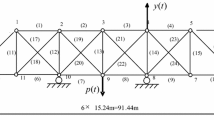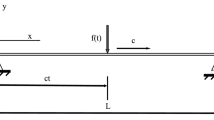Abstract
This paper presents an accurate and effective method, namely, the improved artificial tree algorithm based on the Green’s kernel function method (IAT-GKFM), to identify the load in time domain. The forward problem of load identification is constructed by using the Green’s kernel function method. The forward problem is discretized using the time domain Galerkin method, where a matrix form for load identification is formed. The IAT algorithm is proposed to solve the inverse multi-dimensions problem in the inverse stage, which aims to minimize the measuring dispersion between the calculated response and the actual response. Several numerical examples are conducted. It is demonstrated that the IAT with high performance can provide more optimum results than those of other compared algorithms. Using this optimized strategy, the loads acting on a simple plate and a vehicle roof are reconstructed successfully. The superiority of IAT-GKFM may motivate the improvement of the other inverse problems.








Similar content being viewed by others
References
Liu J, Meng X, Zhang D, Jiang C, Han X (2017) An efficient method to reduce ill-posedness for structural dynamic load identification. Mech Syst Signal Process 95:273–285
Rad JA, Rashedi K, Parand K, Adibi H (2016) The meshfree strong form methods for solving one dimensional inverse Cauchy–Stefan problem. Eng Comput 33(3):1–25
Saeedi A, Pourgholi R (2017) Application of quintic B-splines collocation method for solving inverse Rosenau equation with Dirichlet’s boundary conditions. Eng Comput 33(3):1–14
Shivanian E, Jafarabadi A (2016) Inverse Cauchy problem of annulus domains in the framework of spectral meshless radial point interpolation. Eng Comput 33(3):1–12
Yang HQ, Zhang L, Xue J, Jie Z, Xu L (2018) Unsaturated soil slope characterization with Karhunen–Loève and polynomial chaos via Bayesian approach. Eng Comput 2:1–14
Kaveh A, Dadras A, Geran Malek N (2019) Optimum stacking sequence design of composite laminates for maximum buckling load capacity using parameter-less optimization algorithms. Eng Comput 35(3):813–832. https://doi.org/10.1007/s00366-018-0634-2
Pourgholi R, Tabasi SH, Zeidabadi H (2018) Numerical techniques for solving system of nonlinear inverse problem. Eng Comput 34(3):487–502. https://doi.org/10.1007/s00366-017-0554-6
Thite AN, Thompson DJ (2003) The quantification of structure-borne transmission paths by inverse methods. Part 1: improved singular value rejection methods. J Sound Vib 264(2):411–431
Thite AN, Thompson DJ (2003) The quantification of structure-borne transmission paths by inverse methods. Part 2: use of regularization techniques. J Sound Vib 264(2):433–451
Liu GR, Ma WB, Han X (2002) An inverse procedure for identification of loads on composite laminates. Compos B 33(6):425–432
Zhou J, Cheng Y, Zhang H, Huang G, Hu G (2015) Experimental study on interaction between a positive mass and a negative effective mass through a mass–spring system. Theor Appl Mech Lett 5(5):196–199
Thite AN, Thompson DJ (2006) Selection of response measurement locations to improve inverse force determination. Appl Acoust 67(8):797–818. https://doi.org/10.1016/j.apacoust.2006.01.001
Law SS, Fang YL (2001) Moving force identification: optimal state estimation approach. J Sound Vib 239(2):233–254. https://doi.org/10.1006/jsvi.2000.3118
Liu J, Meng X, Zhang D, Jiang C, Han X (2017) An efficient method to reduce ill-posedness for structural dynamic load identification. Mech Syst Signal Process 95:273–285. https://doi.org/10.1016/j.ymssp.2017.03.039
Qiao B, Zhang X, Luo X, Chen X (2015) A force identification method using cubic B-spline scaling functions. J Sound Vib 337:28–44. https://doi.org/10.1016/j.jsv.2014.09.038
Yan G, Zhou L (2009) Impact load identification of composite structure using genetic algorithms. J Sound Vib 319(3):869–884
Liu J, Sun X, Han X, Jiang C, Yu D (2014) A novel computational inverse technique for load identification using the shape function method of moving least square fitting. Comput Struct 144(C):127–137
Wang L, Liu J, Xie Y, Gu Y (2018) A new regularization method for the dynamic load identification of stochastic structures. Comput Math Appl 76(4):741–759. https://doi.org/10.1016/j.camwa.2018.05.013
Wang Q, Zhou W, Cheng Y, Ma G, Chang X, Miao Y, Chen E (2018) Regularized moving least-square method and regularized improved interpolating moving least-square method with nonsingular moment matrices. Appl Math Comput 325:120–145. https://doi.org/10.1016/j.amc.2017.12.017
Pan C-D, Yu L, Liu H-L, Chen Z-P, Luo W-F (2018) Moving force identification based on redundant concatenated dictionary and weighted l1-norm regularization. Mech Syst Signal Process 98:32–49. https://doi.org/10.1016/j.ymssp.2017.04.032
Gao X, Sun Y (2017) A new heuristic algorithm for laser antimissile strategy optimization. J Ind Manag Optim 8(2):457–468
Goldberg DE (2000) The design of innovation: lessons from genetic algorithms, lessons for the real world. Technol Forecast Soc Chang 64(1):7–12
Onwunalu JE, Durlofsky LJ (2010) Application of a particle swarm optimization algorithm for determining optimum well location and type. Comput Geosci 14(1):183–198
Hao T, Yuan X, Huang Y, Wu X (2015) An improved gravitational search algorithm for solving short-term economic/environmental hydrothermal scheduling. Soft Comput 19(10):2783–2797
Huang SJ (2001) Enhancement of hydroelectric generation scheduling using ant colony system based optimization approaches. IEEE Trans Energy Convers Ec 16(3):296–301
Wei S, Guo X, Chao W, Wu D (2011) Forecasting stock indices using radial basis function neural networks optimized by artificial fish swarm algorithm. Knowl-Based Syst 24(3):378–385
Guan X, Chen G (2019) Sharing pattern feature selection using multiple improved genetic algorithms and its application in bearing fault diagnosis. J Mech Sci Technol 33(1):129–138
Jeong JH, Kim SH (2018) Optimization of thick wind turbine airfoils using a genetic algorithm. J Mech Sci Technol 32(7):3191–3199
Liu Z, Li H, Zhu P (2019) Diversity enhanced particle swarm optimization algorithm and its application in vehicle lightweight design. J Mech Sci Technol 33(2):695–709
Sudsawat S, Sriseubsai W (2018) Warpage reduction through optimized process parameters and annealed process of injection-molded plastic parts. J Mech Sci Technol 32(10):4787–4799
Zadeh PM, Fakoor M, Mohagheghi M (2018) Bi-level optimization of laminated composite structures using particle swarm optimization algorithm. J Mech Sci Technol 32(4):1643–1652
Qiu Y, Wang L, Xu X, Fang X, Pardalos PM (2018) A variable neighborhood search heuristic algorithm for production routing problems. Appl Soft Comput 66:311–318. https://doi.org/10.1016/j.asoc.2018.02.032
Schuster Puga M, Tancrez J-S (2017) A heuristic algorithm for solving large location–inventory problems with demand uncertainty. Eur J Oper Res 259(2):413–423. https://doi.org/10.1016/j.ejor.2016.10.037
Brest J, Bošković B (2018) A heuristic algorithm for a low autocorrelation binary sequence problem with odd length and high merit factor. IEEE Access 6:4127–4134. https://doi.org/10.1109/ACCESS.2018.2789916
Du Y, Yang N (2018) Analysis of image processing algorithm based on bionic intelligent optimization. Clust Comput. https://doi.org/10.1007/s10586-018-2198-8
Bonyadi MR, Michalewicz Z (2017) Particle swarm optimization for single objective continuous space problems: a review. Evol Comput 25(1):1–54
Prasanth RSS, Raj KH (2017) Optimization of straight cylindrical turning using artificial bee colony (ABC) algorithm. J Inst Eng 98(2):171–177
Tereshko V, Lee T (2002) How information-mapping patterns determine foraging behaviour of a honey bee colony. Open Syst Inf Dyn 9(02):181–193
Li QQ, Kai S, He ZC, Li E, Cheng AG, Tao C (2017) The artificial tree (AT) algorithm. Eng Appl Artif Intell 65:99–110
Liu GR, Ma WB, Han X (2002) Inversion of loading time history using displacement response of composite laminates: three-dimensional cases. Acta Mech 157(1):223–234. https://doi.org/10.1007/BF01182166
Karaboga D, Akay B (2009) A comparative study of artificial bee colony algorithm. Appl Math Comput 214(1):108–132
He ZC, Lin XY, Li E (2019) A non-contact acoustic pressure-based method for load identification in acoustic–structural interaction system with non-probabilistic uncertainty. Appl Acoust 148:223–237. https://doi.org/10.1016/j.apacoust.2018.12.034
Author information
Authors and Affiliations
Corresponding author
Additional information
Publisher's Note
Springer Nature remains neutral with regard to jurisdictional claims in published maps and institutional affiliations.
Rights and permissions
About this article
Cite this article
Xu, H., Zhang, L. & Li, Q. A novel inverse procedure for load identification based on improved artificial tree algorithm. Engineering with Computers 37, 663–674 (2021). https://doi.org/10.1007/s00366-019-00848-4
Received:
Accepted:
Published:
Issue Date:
DOI: https://doi.org/10.1007/s00366-019-00848-4




